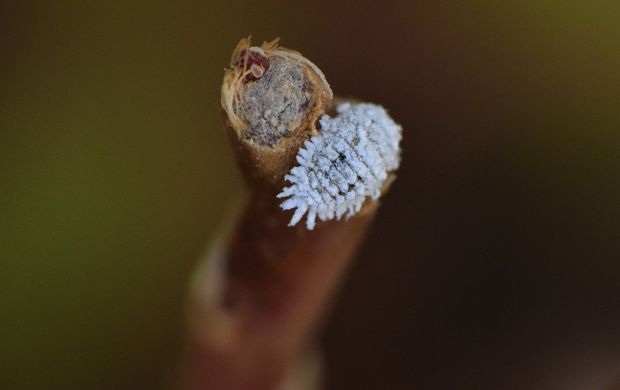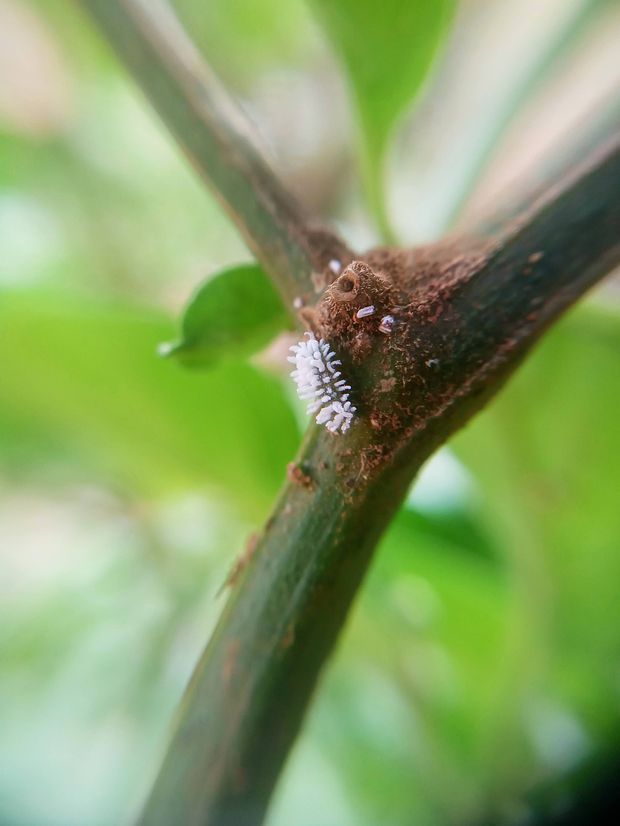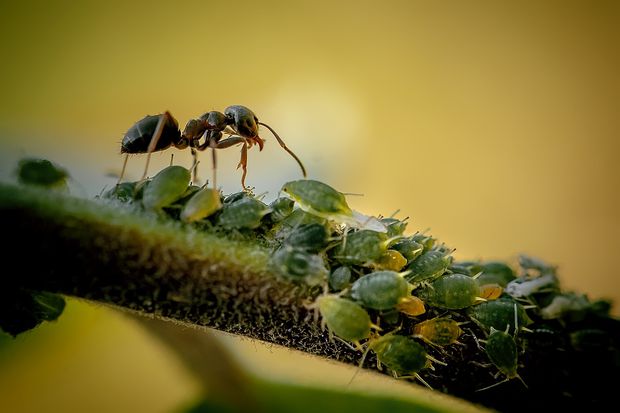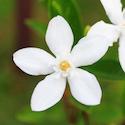Mealybugs are one of the most common Jasmine pests. They are insects belonging to the Pseudococcidae family and Coccoidea superfamily, where also scales are part of. Their physical appearance mimics soft cotton balls, when seen from a short distance, and their bodies are oval-shaped with a soft and waxy cover. They may seem harmless, but they are actually a very harmful pest, that will slowly but progressively kill your plant by feeding on the sap of our Jasmine plant. Not only they are avid feeders of the essential juices of the Jasmine plant, but also, they are keen reproductive insects (able to reproduce asexually without mating), which will deposit thousand of eggs throughout our Jasmine plant. Their average life cycles and egg deposition ranges from 100-200 eggs in cottony egg sacs over a fortnight period. They attach their egg sacs to the leaves or flowers of the Jasmine plant. Mealybugs are bugs found in colonies spread out in the Jasmine plant, usually found in the crown of the Jasmine plant, in branch crotches, stems near the soil and between the stems and the flower buds. Mealybugs, thrive in the warm weather zones, environmental conditions that favour their feeding habits and honeydew deposits in the leaves and stems, which lead to the growth of sooty mould (just like aphids and scales do).

Mealybugs can be eliminated and removed from Jasmine plants through a controlled combination of non-chemical approaches, such as, neem oil, botanical soap insecticides, proper pruning techniques and alcohol dipped swabs cleaning techniques. Releasing mealybug destroyers and generalist predators bugs to keep the bug population under control has proven to be a very efficacious approach to minimise mealybugs infestations.To obtain the best results long term, there should be a proper balance of non-chemical organic approaches and chemical treatments, such as, horticultural oils and insecticides containing acephate or abamectin as active ingredients.

Managing Ants in Star Jasmine due to Mealybugs
Mealybugs just like aphids, white flies and soft scales insects, do excrete honeydew as an excess product of their feeding habits. As we have covered in earlier posts, honeydew is, the perfect ingredient for sooty mould to grow in our beloved Star Jasmine, but also, it is the perfect gourmet meals for ants. This, represents a complication in our Mealybugs infestation in our Jasmine plant, because ants, do develop a symbiotic relationship with the Mealybugs. They ‘farm’ the mealybugs by protecting and safeguarding them both, in their nests, during the winter time, and then, carrying them in to our Jasmine plant. They also protect them from natural enemies in exchange for honeydew production. If this situation is not solved, the integrity of our Jasmine plant will be compromised in no time. The way we mitigate ant infestation problems due to mealybugs, involve ant bait traps (if our Jasmine plant is a well stablished plant with multiple stems) or horticulture glue band (if our plant is less mature). Ants can be easily removed from our Jasmine plant, if we make use of horticultural glue bands around the thicker stem or trunk of the plant. Essentially, it is a water resistant elastic band that it is impregnated in horticultural glue. This glue is a strong adhesive, that it is wrapped around the trunk of our Jasmine plant to prevent these nasty ants to climb and carry mealybugs and other insects. This is a harmless gardening technique to minimise pest controls. When it comes to ants baits, it is super important to use chemicals that will kill them over time, in a way that they take those chemicals to their nest to destroy the entire colony close to our Jasmine plant. A pretty good example are baits made of Borax, as main active ingredient.
Borax is sodium tetraborate decahydrate, and converts to Boric acid when ingested. Ants start seeing their feeding habits diminished and they eventually die. Borax is commonly used as laundry detergent for which is quite accessible for everyone to get. You can make your own homemade Borax mixture bait by easily mixing 1/2 cup of sugar plus 2 teaspoons of borax powder with a 250 ml water in a glass jar with cotton balls. Place this jar (with holes in the cap) close to the nest and close to the jasmine plant. The ants will go for it and die. After the ants are gone, the mealybugs excess will be quite exposed and the infestation level will decrease pretty quickly, making it easier to take care of the remaining bugs.

Techniques to get rid of Mealybugs
Compared to other insect pests, Mealybugs are not particularly dramatic to get rid off, if the level of infestation is not in a point where the plant is not going to come back. If it is a small infestation in our Jasmine, we can easily clean the Jasmine plant manually, by physically removing the mealybugs with tweezers and straight water flashes. We can also use a medium size cotton swab dipped in alcohol to be rubbed in the affected areas of the plant. This really helps to force those insects to not feed in the sap anymore and to leave our Jasmine plant. For larger mealybugs infestations, cleaning the plants manually and applying the ethanol method above described, won’t be enough to reduce the number of bugs. We need (in addition) to start applying a mixture of Neem oil plus water and apply it to the plant via damped clothing. Then rub it around the affected leaves and stems. When the number of insects decrease, you can move to a spray bottle. Keep applying this mixture for two weeks and you will see a big decrease in the bugs burden. Not only that, but also insecticidal soaps (Mix 2.5 tablespoons of vegetable oil plus 2.5 tablespoons of pure liquid soap with 1 liter of distilled water) and then thoroughly spray the Jasmine plant for about two weeks. The way insecticidal soaps work is by bursting the fatty acids in the soap to suffocate the mealybugs (and other insects) by having their cell membranes disrupted and having their exoskeleton dissolved and dehydrated. For persistent and large infestations, there is a very effective organic technique, such as, the controlled release of generalist predators, like ladybugs, which can help as population control by feeding on these mealybugs early in the growing season. Sometimes, only organic approaches, are not enough to cope with a bad mealybug infestation, for which, the aid of chemical products are required. The most commonly applied systemic insecticides are high in neonicotinoids.
These insecticides have a translaminar activity including acephate or abamectin as active ingredients. When applied to leaves, roots and flowers, adult mealybugs respond well to this systemic insecticides. Horticultural oils, such as, dormant oil (Damoil, Volk oil) can also be quite effective, although, multiple applications are often required. Make sure to keep applying these oils for a month, otherwise, the eggs that are under the female may remain alive and thus, the infestation can rapidly rebound.
To wrap it all up, beware of the ants joining the Jasmine plant, because of a mealybug infestation, inspect your Jasmine plant regularly and immediately act if you see any mealybug in the stems, as females come loaded with millions of eggs, ready to be deposited. In no time you can have a pretty bad infestation in your Jasmine plant.
